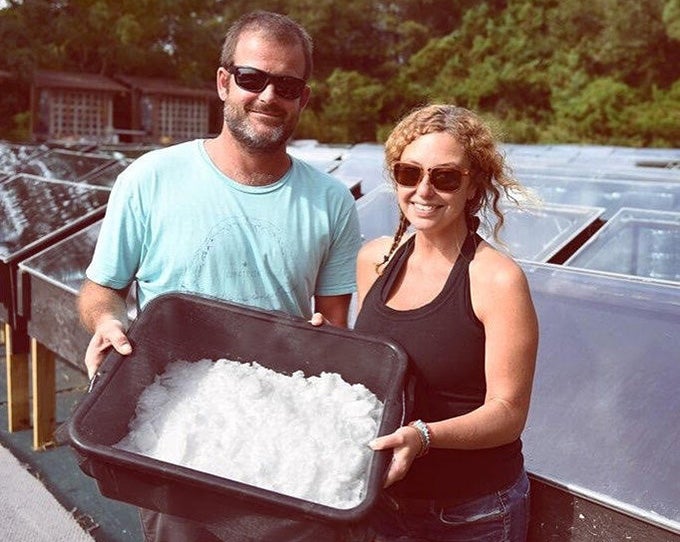It’s a blisteringly hot summer day on Hatteras, a barrier island off the North Carolina coast, and Brian and Shaena McMahon’s solar ovens are cooking. Filled with ocean water that heats up to about 185 degrees Fahrenheit, just short of boiling, these black glass-covered containers are harvesting sea salt. As the water evaporates, the little white salt crystals fuse together into clusters. “You see how it flakes up and starts to crystallize and we get these beautiful flakes,” Shaena says. As clusters dry up, they form bigger clumps that the couple breaks, packages, and sells. “It’s about a two-month process from the time we put in the water to the moment when it’s in a pouch, ready for sale.”
Artisanal sea salt making may sound like a new hot trend, but it is one of the oldest vocations on earth, dating back to antiquity. French historian Marc Bloch suggested that the early Neolithic site of Jericho rose to its extraordinary prominence because of the processing and exchange of salt from the Dead Sea. Roman philosopher Pliny the Elder wrote, “Heaven knows, a civilized life is impossible without salt.” The sodium and chloride ions that comprise the salt molecule NaCl are essential nutrients without which humans can’t live. The body needs sodium to control nerve impulses, maintain a proper fluid balance, and contract and relax muscle fibers including those in the heart and blood vessels.
An old Norse folktale states that this important nutrient is made by a magic salt mill in the bottom of ocean, steadily grinding away. And there indeed is a mill, of sorts—a 40,000 mile-long rift that runs through all the major ocean basins, where liquid volcanic rock and water intermix. It is in that geological mill where seawater becomes enriched with many minerals, including sodium, chloride, iodine, carbon, boron, bromine, nitrogen, and others. When seawater naturally evaporates, the resulting sea salt contains over seventy other minerals and trace elements, generated by the complex chemistry of the sea.

While much of the commonly-used table salt today is mined on land, that salt originally came from seawater—the ancient oceans that later dried up, leaving behind residue. Large parts of Utah and western Colorado contain thousand-foot thick salt deposits, which grew from a large shallow sea that was there ages ago. Such huge deposits are where many industrial salt-mining operations take place today. The environmental impact of these operations can’t be overlooked. Large-scale salt mining companies usually use trucks and other big machinery powered by gasoline. The commercial sea salt harvesting process is also energy-intensive. “It’s usually boiled or baked using fossil fuels, and moved using big trucks,” Brian says.
Before the Industrial Revolution, however, solar salt making was all the rage in the United States. At Syracuse brine springs, where water was originally evaporated using fires, salt-makers first tried solar evaporation in 1822—and then fully switched to this method. Around 1830, the Atlantic seaboard generated over half a million bushels a year of solar sea salt. In the 1920s, San Francisco’s solar plants directed seawater through a series of open ponds to gradually increase salinity through evaporation—and then released the brine into the crystallizing ponds where salt crystals would start to form. As one historian wrote, “letting the sun do the work gratis,” eliminated fuel expenses.

The McMahons are following the same ideology at Hatteras Saltworks. Their setup runs on solar heat and wind that passes through the ovens, adding to evaporation. Moreover, not only the salt, but even the ovens themselves are mostly harvested from the sea; Brian builds them from the driftwood that washes up on Hatteras shores. “After big storms when the decks from homes fall into the oceans, a lot of wood washes up and I comb the beaches for it,” he says. “And I use glass panels from old, destroyed Andersen glass doors for oven tops.”
Weekly Digest
The couple has harvested sea salt in other places, including Hawaii, but Hatteras Island is a particularly flavorful spot, according to Brian. The confluence of the warm Gulf Stream and the cool Labrador Current makes the water high in salinity and many other minerals. To diversify flavors, Brian smokes some of his harvest with recycled pecan wood while Shaena mixes in herbs like rosemary and lavender. “We are getting to the point where we are making as much as we can and we sell it all,” Brian says. “Many retail accounts off the island are calling us, asking for orders.”
They are building larger, more efficient ovens to increase production. As Brian points out, in the old times, people knew how to use solar energy efficiently. That means we can do it too.







